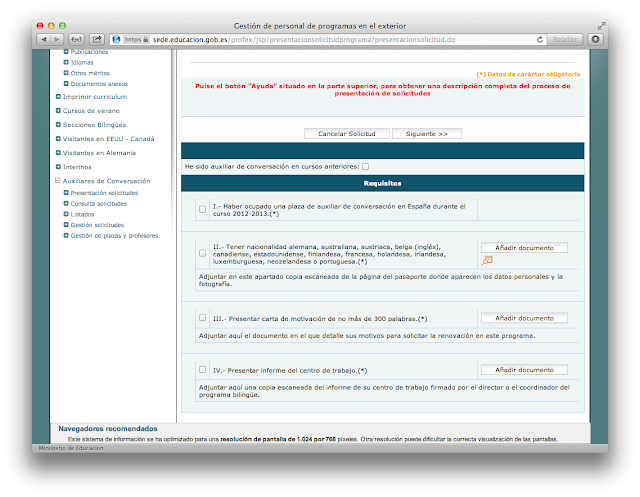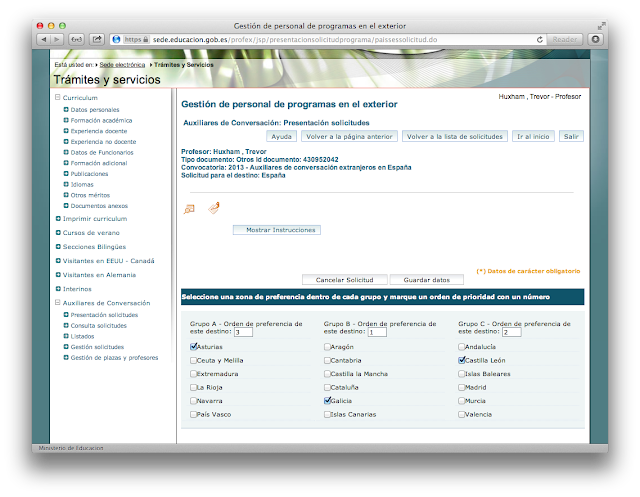How to Renew for a Second Year for Spain’s Language Assistant Program
LAST UPDATED JANUARY 2014
After applying and getting accepted into Spain’s language assistant program, and after living and working abroad for a whole school year, you’ve decided you want to do it all over again. You’ve read through Spain’s official how-to-renew guide, but their guide for renewing via Profex is all in Spanish and the application period begins tomorrow…so what do you do? Read below, that’s what!
In this blog post, I want to make it as clear as possible how to renew for Year 2 (or Year 3…) since the process is similar, yet different, from Year 1. If you finish reading the post and still have questions, leave a comment and I’ll try to answer it!
 |
| Me at the Plaza de España in Sevilla |
1) Figure out where you want to renew
 |
| Sevilla’s Torre del Oro and the Guadalquivir River at the blue hour |
Not everyone chooses to stay at their same school for a second or even a third year; sometimes people want to change from a rural to an urban setting, from a primary school to a secondary one, or from one province or region to another. Or maybe the school they got placed in was a disaster and they needed to get out of a bad situation. Regardless, when you do renew, since you have priority over first-year applicants, you have a better chance of getting an ideal placement for the next school year.
The first option is to simply remain at your present placement for another year—simple as that. I have a friend who is staying at her school for Year Two but moving to an apartment in a bigger city, just to change things up a bit, but you can keep on living in your pueblo if you want!
Next, you can choose to stay in your current Autonomous Community (Andalucía, Castilla y León, Galicia, etc.) but move to a different city or province. For example, someone I met at the Jaén orientation had been in a small town for her first year but moved to Úbeda for her second—both in the same province—and one of my good friends from this year is moving from a rural village to the big city of Sevilla on the other side of Andalucía. If you’re staying in the same autonomía, you’re more likely to get placed in the province, city, and sometimes school of your choice.
Finally, it’s possible to transfer to an entirely different Autonomous Community altogether. Travel blogger Liz Carlson went from Córdoba in Andalucía to Logroño in La Rioja, one friend I met this year in the south had worked in Palencia (Castilla y León) the year before, and I personally am moving from Andalucía to Galicia. When moving from region to region, you get less preference on city and school placements, but you’re essentially assured you’ll get a job in the community you want.
2) Endure the dreaded Profex
Ah yes, ourWhat you have to do is, once the application period begins in January, sign in to your Profex account and go to Presentación solicitudes under the Auxiliares de Conversación menu on the sidebar. (All your information in the Curriculum section from last year will automatically carry over, so no worries about spending hours filling in your address, education, blood type, list of exes, etc.) At the Presentación solicitudes screen, select “[year] - Auxiliares de conversación extranjeros en España” and — THIS IS THE MOST IMPORTANT PART — click on the Renovación solicitud button, NOT the Nueva solicitud one. I have a friend who accidentally clicked on Nueva instead of Renovación and it totally screwed up her renewal chances. Thanks, Spain.
OK, next part. The first screen of questions asks you first if you’ve been an auxiliar in previous courses—check this box. Then, check all four boxes, I to IV, and upload a scan of the ID page of your passport, your statement of purpose (in Spanish), and a scan of the informe del centro (your performance review from your school and your declaration of where you want to teach). It’s okay if you don’t upload everything at this step; you can go back and finish things later…I think. The website is super glitchy so anything is possible.
Next, you get to choose your regional preferences, just like first years get to. Remember that the program isn’t available to North Americans for Catalunya, Ceuta y Melilla, Islas Canarias, or Valencia.
The following screen is a long list of lots of questions:
- (I) asks you to select which language you are going to teach (English, French, Chinese, German, or Portuguese)
- (II) asks you if this is your first time renewing
- (III) is tricky because this required question asks you if you’ve previously renewed to say how many times you’ve renewed…just select once
- (IV) asks if you want to stay at the same school
- (V) asks if you want to stay in the same Autonomous Community but not necessarily in the same school
- for (VI) you write out your current school and city
- (VII) asks if you want to stay in the same Autonomous Community or not, and
- (VIII) is a text box where you can add additional information like age and city preference or other notes.
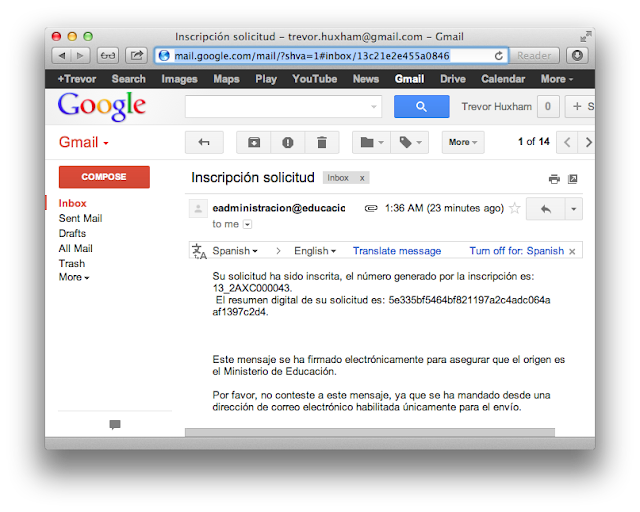 |
| This is what happens when you stay up until 2am in Spain—you get inscrita #43. Aww yeahhhhh! |
Once all this is filled out, click on the Inscribir solicitud button. Assuming all goes well, it will say “El proceso terminó correctamente” and you will receive an email with your application number. On that same screen, you can click on the “Volver a la página anterior” button, which will take you to a page where you can click on the PDF icon at the bottom to download the PDF application form that you must sign and mail in to an education office.
3) Mail in your PDF application
If you’re staying in the same Autonomous Community, you send that signed PDF to your regional education office; for example, in Andalucía, you have to mail it to the Consejería de Educación in Sevilla.
If you’re changing regions, you mail it in to the Ministry office in Madrid. “Extracomunitarios” refers to people who aren’t EU citizens, basically. The address is:
Ministerio de Educación, Cultura y DeporteOnce all your documents have been uploaded and your PDF application has been mailed in, a worker bee will look over your file and move you from inscrita to admitida, and you’ll be ready to go.
Subdirección General de Promoción Exterior Educativa
Programa de Auxiliares de Conversación – Cupo Comunidad
Paseo del Prado, 28, 5ª planta, despacho 524
(A la atención de Javier Menéndez [extracomunitarios] o Victoria Hernández [comunitarios])
28014 MADRID
4) Receive your placement
Thankfully, if you’re renewing (for a second year, at least), you have priority over first years and thus will be the first to get your placement for the next school year. Whenever Spain starts rolling out placements in April or May, you’ll soon find out where you’ll be working in the fall. Accepting is just like the first year process; you receive an email and then you go into Profex to either accept or decline the offer. Congratulations!
5) Renew your residency
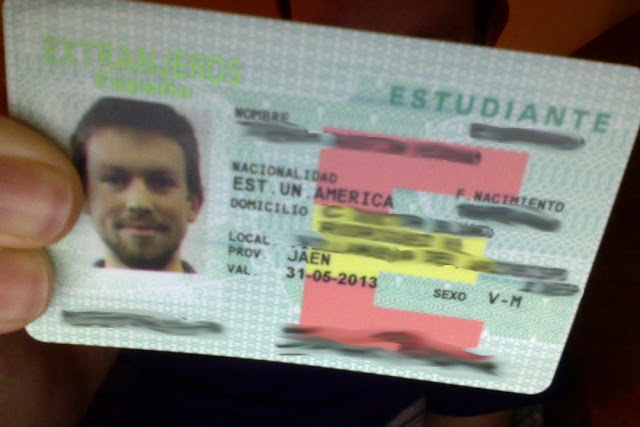 |
| My TIE card…which expired May 31st (ugh) |
This is the worst part of the renewal process. For this program, you initially get a student visa from one of Spain’s ten embassies and consulates scattered across North America and, once you arrive in the country, you go to a provincial foreigners’ office (oficina de extranjería) and apply for a NIE (number) and TIE (ID card) to make you legal for the duration of the school year. Depending on the province, your card (and thus your legal status) will expire either May 31st (the last day of the program) or sometime in September, a little less than a year after the program begins. You can begin the renewal process between 60 days before and 90 days after the expiration date; however, this is where things turn into a mess.
In a perfect world, your NIE wouldn’t expire until late September, when you come back to Spain after going home or traveling for the summer, and you wouldn’t have to worry about questionable legal status when re-entering Spain. But many provinces (e.g., Córdoba and Jaén) set your NIE to end on the last day of the program—May 31st—making you technically an illegal alien in the EU when you wake up June 1st. Sucks to suck! To make matters worse, these foreigners’ offices refuse to renew your NIE if you’re moving from one province to another. And now we get to the crux of the problem.
You don’t find out about your placement for the next school year until May—fewer than 30 days before your status expires. And 90 days into the future from May 31st is only August 31st—an impractical date to arrive back in Spain (one month before classes start with no paycheck!). So what you have to end up doing is run across the country like a chicken with its head cut off to the foreigners’ office of the province you are moving to and apply to renew there.
But it gets worse—the renewal process involves several trips: for the initial application, for the new card, and for picking up the new card. The website says it could take up to three months for everything to go through.
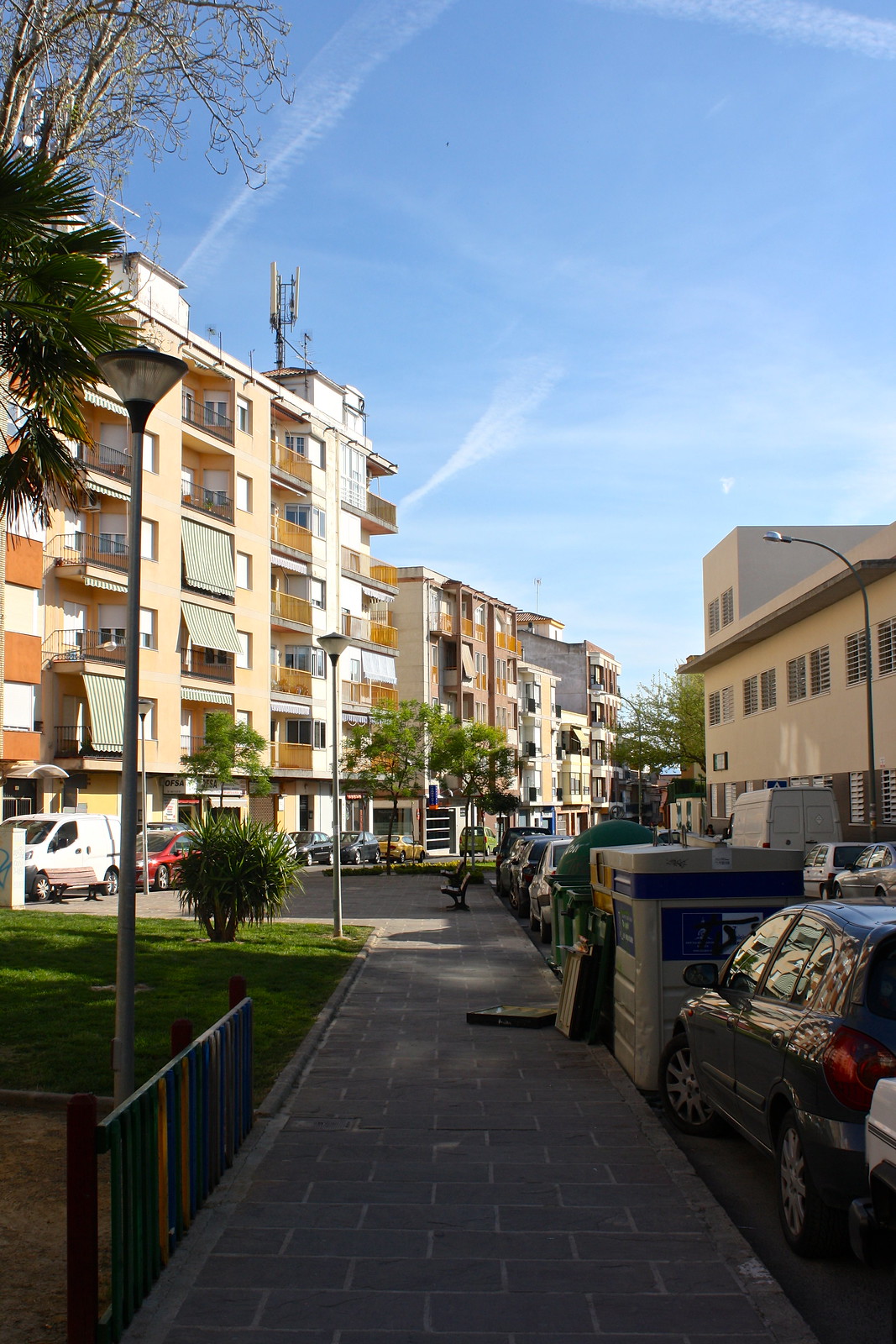 |
| Calle Explanada, a street I lived nearby in Úbeda |
And to rub salt in your wounds, some provinces (La Rioja and Sevilla, for example), require you to be empadronado—officially registered as living in that province, with proof of an apartment contract.
This whole process is extremely impractical for 1) those language assistants who are changing regions 2) those language assistants whose status ends May 31st and 3) everyone, since we have no means of sustaining ourselves or health insurance during the summer months and can’t afford to just twiddle our thumbs while waiting up to three months for approval before going home for a visit.
And even if you do get everything squared away, renewal-wise, you have to get an autorización de regreso before leaving under your expired-but-being-renewed TIE, under which you are allowed to come back into the country legally but only in under 90 days. So you’re pretty much screwed even if you manage to get your act together by, for example June 10th, because you’d have to return to Spain no later than September 9th, which is still rather early.
What me and a lot of other friends are doing this summer is simply going back home and getting a whole new student visa. Ugh.
6) Get in contact with your school!
 |
| Central Úbeda at sunrise |
Since you’re renewing, you’ll hopefully get contact info for your school in May before school gets out for the summer in late June. This gives you plenty of time to start emailing your school director and/or bilingual coordinator about general facts about the school, whether teachers carpool, what kind of work is expected, etc. What’s even more important is to get the email address of the previous language assistant so you can pick their brain about everything! Usually they will be able to answer your questions more fully and give you a feel for how they made their year at the school work.
Have you successfully renewed as a second or third year auxiliar de conversación before? What tips would you give potential renewals about the process? Add them to the discussion below!

